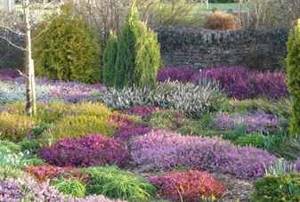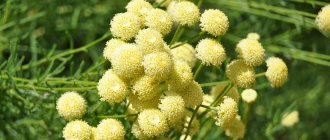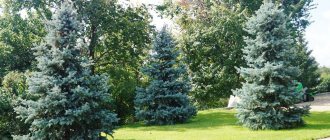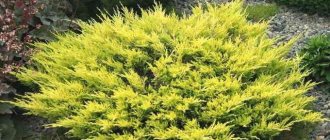If you need a beautiful, completely unpretentious perennial for your garden that can grow in any terrain, then choose heather. The evergreen plant is the record holder for life expectancy among herbaceous flora (life cycle 40 years). Depending on the variety, it can reach from 25 to 95 cm. Belongs to the Heather genus. Under natural conditions it grows almost all over the world. Feels great in swamps, forests and steppes.
- Seeds
- What kind of soil should it be?
The plant is highly branched, the stem is brown-red. The opposite leaves are triangular in shape. One-sided brushes contain numerous drooping flowers of pink and lilac shades. The quality of the fruit is a small box in the shape of a tetrahedron. It contains a large amount of small seeds. They ripen in September. The flowering period is long: from June to the end of August. Hardiness, unpretentiousness and pink mist of flowering make heather one of the most popular crops in garden decoration.
Plant propagation
The crop is propagated in spring and summer in the following ways. Experienced gardeners advise propagating the plant in the spring. During the summer period it will have enough time to take root and adapt.
Seeds
This method is the most time-consuming and complex. Why is it not popular? The seeds are planted in a greenhouse for seedlings. Young seedlings are transferred to open ground only after 12-18 months.
By layering
For this method, human intervention is not needed. The garden planting copes well with the function of propagation on its own. The branches adjacent to the ground take root after a certain time. If necessary, the process can be accelerated and healthy shoots can be secured to the ground by sprinkling them with peat. After a year, the young seedling can be transplanted from the mother bush to a permanent place of “residence”.
Apical cuttings
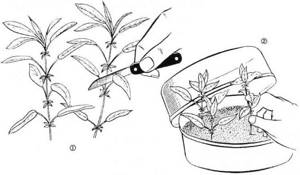
Preparation of planting material begins in August. Cuttings are cut from strong plants during the dormant period. In order for the separated part of the branch to take root, it is planted in a container with a special substrate (sand and peat, in a ratio of 3:1). The room temperature should be no less than 15 and no more than 21 degrees. These are optimal conditions for successful germination. The winter period is sufficient for the rooting and development of young heather. In spring, you can plant the seedling in the soil.
Seedlings
You can buy them in a special nursery. The preferred distance between holes is 40-50 cm. This distance will allow the root system to grow horizontally. A representative of the flora needs mycorrhiza to be vital. To obtain it, the bush must be mulched at the base of the seedling. To do this, use small chips or sawdust of conifers.
By dividing the rhizome
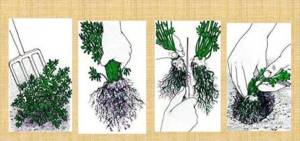
This method is the simplest and most effective, and is the leader among the others. In October, the garden planting is carefully removed from the hole and divided into parts. The lump of earth remains untouched. The cuttings are planted immediately in open ground.
How to create a composition from heather?
Before designing a landscape design using heather, it is necessary to determine what appearance the future clearing will have. It is created for a long time, so in this case it is necessary to think through everything to the smallest detail.
In this case, a person must take into account certain aspects:
- When drawing up a site plan, it is recommended to first determine the height of the bushes and their ability to grow. The tallest bushes must be planted in the center of the clearing. Low crops should be planted along the edges of the clearing.
- If varieties grow intensively, then at least 8 crops must be planted per square meter.
- If the growth of the bushes is weak, their planting is carried out more intensively.
- When planning landscape design, it is necessary to determine the flowering time of the bushes.
You may be interested in: Flower beds in a summer cottage: the most popular types, descriptions of flowers with photos and names
If a person makes the correct selection of crops, then his composition will look harmonious and very beautiful, as in the photo below.
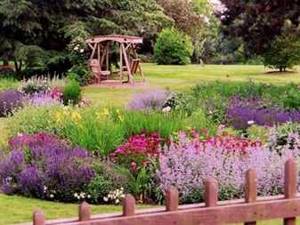
Planting and care
What kind of soil should it be?
Heather has minor soil requirements. It can grow successfully in almost any, but it gives preference to acidic (up to 6 units). Using a special device for measuring pH levels, you can select the optimal area. If the indicator is higher, then the situation can be corrected by adding the following substances to the soil: sulfur, malic, oxalic, acetic acid, peat. To prevent the soil from becoming acidic, it is better to make a good drainage layer. Alkaline soil and excess fertilizers have a detrimental effect on the crop.
You can prepare the ideal substrate yourself. To do this, you need to take the soil under the coniferous trees, mix it with peat, sand (ratio 1:3:1) and add 50 grams of sulfur.
How to prepare a landing site
Preference is given to open sunny areas; slightly hilly terrain is acceptable. The top layer of earth (about 25-35 cm) is removed from it. The cleared area needs to be compacted and watered generously with a mixture of water and apple cider vinegar. The area is filled with pre-prepared substrate from above. If the plant grows poorly, the reason may be the lack of thread-like mycelium in the soil. It is very important for the heather root system to extract useful substances from the ground.
Fertilizers

The culture is oligotrophic. She has little nutritional requirement. If necessary, if the garden planting is attacked by diseases or it grows poorly, a complex of mineral fertilizers is applied . The procedure is permissible no more than once every 12-14 months.
Weed control
For active growth, development and full disclosure of decorative qualities, heather must receive a sufficient amount of nutrients from the soil. Weeds can interfere with this: they impoverish the soil. Gardeners regularly fight them.
A haircut
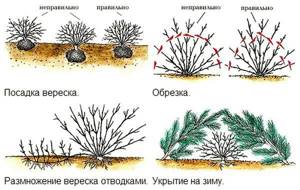
For greater density and density, the bush must be trimmed in autumn and spring. Trimming the tops of shoots provokes more active growth. It is permissible to trim shoots to 4-5 cm. Do not let the bush mold. The loss of the natural appearance will have a bad effect on the decorativeness and originality of the plant.
Watering
Under favorable weather conditions, watering is not necessary. But, if dry weather lasts more than 15 days, then moderate application of moisture will not be superfluous. A day after watering, shallow loosening is carried out.
Diseases and pests of perennials
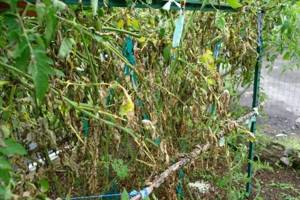
Late blight using tomatoes as an example
An excess of moisture in the air and soil leads to late blight . This unpleasant fungal disease leads to the appearance of a gray coating on the shoots. Under its influence, the branches bend and the leaves fall off. The affected parts of the heather should be disposed of, and the remaining fragments should be treated with a special solution ( copper sulfate, foundation, etc. ).
When preparing the substance, you should strictly follow the instructions. Treatment is carried out 3 times, the interval between them is one week. You can use the solution as a prophylaxis in November and March. The most common pest that attacks heather is the scale insect. She sucks the juice from the plant. To get rid of it, just treat the bush with a soap solution or insecticide.
Preparing for winter
In regions with cold and long winters, a representative of the flora may die. Therefore, the drainage layer is doubled. If there is no stagnation of water at low temperatures, then the garden planting will safely survive the cold season. To provide additional safety, it can be covered with spruce branches, dry leaves or large tree shavings.
Choosing plants for a heather flower garden
A mixborder with an all-round view is located on a low slope with a slight difference in height, no more than 0.5 m. Such flower beds should look decorative all year round, so the base was created from conifers: thujas, junipers, mountain and Weymouth pines, microbiota and hemlocks of various shades and texture of needles, low-growing. Some species, such as junipers and microbiotas, change the color of their needles in winter and return to their color in the spring, which also diversified the picture.
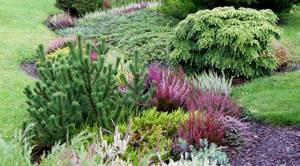
Heathers were introduced for color accents. They look incredibly colorful in the fall. Since in the spring, in April, they have an unsightly appearance, until fresh branches with buds begin to grow, junipers, thujas and microbiota distract attention. There is an excellent plant for such a mixborder - andromeda multifolia, or podbel. This heather plant blooms in spring with delicate pink bell-shaped flowers, its narrow leaves are gray-blue.
Also, for a spring accent, varieties of dense rhododendron were planted. This type of rhododendron is classified as dwarf. Plants are 0.3–0.5 m in height and 0.5 m in diameter, the shape of the crown is cushion-shaped, they bloom very luxuriantly, the leaves are narrow, small, and during flowering they are practically invisible. The dense rhododendron is quite winter-hardy, tolerates frosts down to -23 ° C, but I cover it in late autumn with pine litter from pine trees. It looks decorative and winters well. I simply fill the top of the bush with dry pine needles until a stack is formed that completely covers the bush of the plant.
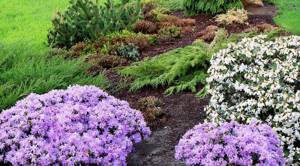
Heather: legend and history
Breeders have now obtained several hundred varieties of heather of different colors from wild heather. In Russia, about fifty varieties can currently be purchased, but they differ in flowering time and color. Therefore, the choice is great, there is scope for your imagination - creating an original design in the garden.
.
Among many peoples, heather was considered an unusual plant; songs and poems were dedicated to it. According to Scottish legend, heather is the only plant that responded to God's request and agreed to grow on the bare hills.
The English planted heather in gardens in the mid-17th century. Then, for unknown reasons, this amazing plant was forgotten. Many considered it too ordinary and simple, when you can plant, for example, the queen of flowers - the rose. And only relatively recently, heather began to be actively used in landscape design, creating unique compositions for garden decoration.
In 1994, for its fiftieth anniversary, the Main Botanical Garden in Moscow received a luxurious gift - several varieties of heather from German breeders from Oldenburg. Since that time, this plant has won the hearts of Russian gardeners.
Description of heather
This is a flowering shrub with a height of 30 cm to 80 cm. Numerous branches are completely covered with small leaves in the form of scales and flowers that look like miniature bells.
After flowering ends, they dry out, but do not fall off, so it seems that the heather is constantly blooming. In nature, it is found in peat bogs, dry sandstones, and pine forests. Lives for several decades.
The shrub is ideal as a plant for rock gardens and rockeries. But too large a planting area will look monotonous, despite a wide palette of colors.

Heather is best combined with other species. But this is a light-loving plant, so you should not select large companions for it. Over time, the heather will be in the shade, and will no longer be so pleasing to the eye.
Azaleas, hydrangeas, low-growing rhododendrons, miniature representatives of conifers and decorative deciduous shrubs are well suited.
Erica - growing in the garden
Heather is of great benefit to beekeepers. This is a late honey plant. The collected delicacy has a dark color, fragrant aroma and tart taste, generously endowing its owners with healing properties.
COLOR PALETTE OF HETHER VARIETIES
Florists and gardeners pay attention to heather quite often. This is due not only to the fact that it can grow even in swampy, mountainous and sandy conditions, but more due to its beautiful elegant texture. Although there is only one species in nature - common heather or Calluna vulgaris, the color palette of its various varieties (more than 300) allows you to choose the most suitable options for the shades of flowers and foliage:
- Purple, white or lilac-pink bells with needle-shaped lush green leaves, like decorative heather.
- Pure white or greenish-white inflorescences and small bluish foliage are characteristic of the tree-like variety.
- Red or pink flowers, collected in racemes, and bright green leaves can be seen when Calluna Rose blooms.
- Terry light pink flowers and dark greens (such as the variety “Bil”).
- Purple or lilac-pinkish buds and golden-yellow (summer) or copper-crimson (autumn) leaves are amazing metamorphoses of such varieties as “Boskop” and “Golden”.
These shades are the most common. But there are also other variations - purple and ruby red inflorescences, purple and dark pink flowers, and the greens sometimes take on bluish-white and orange shades.
Features of growing heather in the garden
Heather is an undemanding plant. The place for growing this crop can be:
- Sandstone;
- Rocky slopes;
- Dry pine forests.
Despite the fact that the culture is unpretentious, it is best to plant heather in acidic soils.
When planting heather on a site, you must ensure that the area is well lit. If you plant the plant in shady conditions, this will shorten the flowering period. Do not plant the crop in excessively wet soils. If there is high moisture in the area, then it is necessary to first install drainage.
How to choose heather seedlings and plant them?
When choosing seedlings, a person must be guided by certain rules.
The bush must have young shoots and be characterized by the presence of vegetative properties . Before purchasing a bush, it is recommended to determine the fragility of the branches.
You may be interested in: Primroses in spring garden design: some of the most beautiful primroses
Planting should be done from late April to early May. When planting a crop during this period, the highest quality rooting will be ensured. When planting a plant, it is necessary to dig a hole correctly. Its depth should be such that the root collar remains on the surface.
After planting, the soil around the seedling is mulched using peat, pine needles or sawdust.
Planting of a plant must be treated as responsibly as possible, since further rooting directly depends on it.
